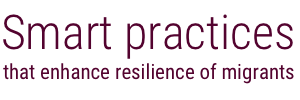Provision of crowd-funded microloans through an internet platform.
UNHCR worked with Kiva Zip and Refuge Point on a pilot microfinance project to provide loans to refugees in Nairobi. The project aimed to assist refugees to acquire capital and grow their businesses.
RefugePoint is an organization that works with the most vulnerable refugees in African countries. It leveraged its reputation to serve as a trustee, and selected refugees eligible to receive the microfinance loans; however, it did not bear financial responsibility for the loans.
Kiva Zip is an online crowd-funded micro-lending platform founded in 2005. The organization aims to connect borrowers directly to lenders, expand access to capital and reduce the cost of capital. Kiva Zip uses an online website to connect lenders from around the world to beneficiaries. Kiva Zip expanded into Kenya in 2011, providing 10,000 loans to Kenyan entrepreneurs including refugees. Lenders from around the world could extend a small no-interest loan (from 5 US dollars) towards refugee businesses. Refugees were then provided payments via mobile money (M-PESA), therefore removing the need for a bank account or internet access. Loans were provided to the refugees using a graduated system. The maximum amount for a first loan was 125 US dollars (~10,000 Kenya shillings). Once a refugee established a repayment record (by repaying a loan successfully), s/he could move on to a higher credit level. Due to funding constraints, Kiva Zip discontinued operations in Kenya, despite the success of its lending programme.
45 loans averaging 170 US dollars were provided to 27 distinct recipients between 2012 and 2014. The repayment rate was 90 per cent and loans tripled the average income of recipients.
Design. [P1] Focuses on the need of migrants to earn a livelihood by growing business ventures. [P3] Supports the entrepreneurial aspirations of refugees.
Programme. [P9] Responds to displacement of refugees into Kenya.
- The lack of sufficient start-up capital hampered the ability of Kiva Zip to grow in Kenya.
- Starting with small loans and graduating to larger loans played an important role in high repayment rates.
- Integration with mobile platforms and with mobile money expands the client base and makes the services easier to use.
- The crowd funding model for micro-loans can work in Kenya given sufficient start-up capital.
Smart practices
Smart practices report and database survey
About the report
People migrate in pursuit of a better life for themselves and their families. As described in the International Federation of Red Cross and Red Crescent Societies’ (IFRC) Policy on Migration, “migrants are persons who leave or flee their habitual residence to go to new places – usually abroad – to seek opportunities or safer and better prospects.
Read more
About the International Federation

